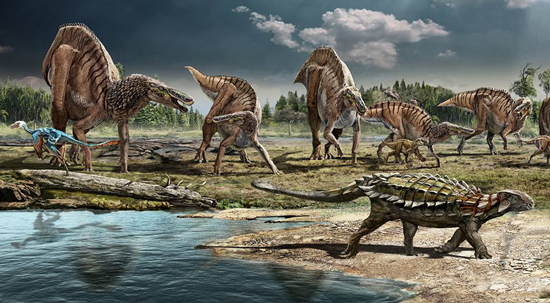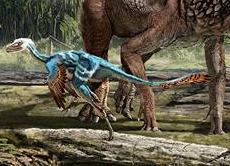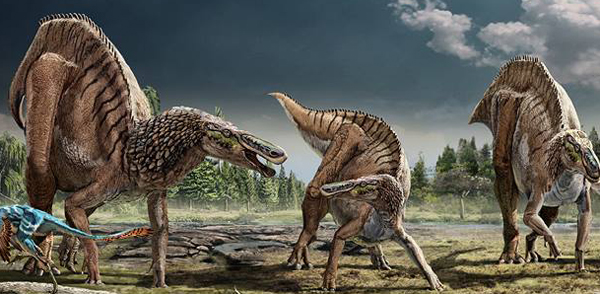The Late Cretaceous of Northern China and Some Beautiful Artwork
The Late Cretaceous of Northern China
Today, we wanted to post up some more of the amazing artwork produced by Zhao Chuang that was created in association with the Peking Natural Science-Art Organisation (PNSO). Zhao Chuang has an extensive portfolio of palaeoart, we have already featured a number of illustrations of prehistoric scenes and individual dinosaurs and other long extinct creatures on this blog. However, rather than focus on one particular dinosaur we thought that for a change, we would post up an imagined dinosaur diorama.
Northern China in the Late Cretaceous

Picture credit: Zhao Chuang (PNSO)
A Stunning Piece of PNSO Palaeoart
The picture (above), depicts northern China (Inner Mongolia), in the Late Cretaceous, approximately 77-75 million years ago (Campanian faunal stage of the Late Cretaceous). The armoured dinosaur in the foreground (left), is Pinacosaurus (P. grangeri), a member of the Ankylosaurinae. At around five metres in length, this heavily armoured dinosaur probably had little to fear from the numerous dromaeosaurids such as Velociraptor and Tsaagan which shared its environment, although there is some evidence to suggest that larger theropods (tyrannosaurids) were present.
The artist has depicted a dromaeosaurid on the extreme left of the diorama. This fleet-footed predator is on its own, no pack or flock behaviour for this little carnivore is inferred. The feathered dromaeosaurid is making a swift exit as it does not want to get involved with the herd of duck-billed dinosaurs approaching the oasis, although in truth, these herbivorous giants have very little to fear from this particular theropod.
A Closer View of the Small Theropod Dinosaur Depicted in the Dinosaur Diorama

Picture credit: Zhao Chuang (PNSO)
Plesiohadros?
We have commented on this artwork on a previous post, but on that occasion we did not identify the hadrosaurids approaching the waterhole. Although the Hadrosauridae has an extensive fossil record in northern latitudes, identifying the group approaching the oasis in this illustration is quite tricky. Remarkably, despite the multitude of vertebrate fossils associated with the Djadokhta Formation (sometimes also referred to as the Djadochta Formation), of northern China, very few ornithischian dinosaurs have been identified.
The majority of ornithischian dinosaurs known from this region are either members of the armoured Thyreophora such as Pinacosaurus or Neoceratopsia (part of the horned dinosaurs group).
The duck-billed dinosaurs could represent Plesiohadros (Plesiohadros djadokhtaensis), which is known from both cranial and postcranial fossil material from the same locality where Velociraptor fossils have been found.
As Plesiohadros is the only hadrosaurid discovered so far from the Djadokhta Formation , then the large herbivores in the diorama could represent this species. However, as Plesiohadros was only named and described in 2014, if the artwork had been completed earlier, then the presence of hadrosaurids could be speculative on the part of the illustrator.
Are the Hadrosaurids Depicted in the Diorama Plesiohadros?

Picture credit : Zhao Chuang (PNSO)
Whatever the species represented, the illustration is truly spectacular and one of our favourites.
To view the range of PNSO prehistoric animal models and figures available from Everything Dinosaur: PNSO Age of Dinosaurs.
Our congratulations to the artist for the fabulous illustrations.
The Everything Dinosaur website: Everything Dinosaur.

